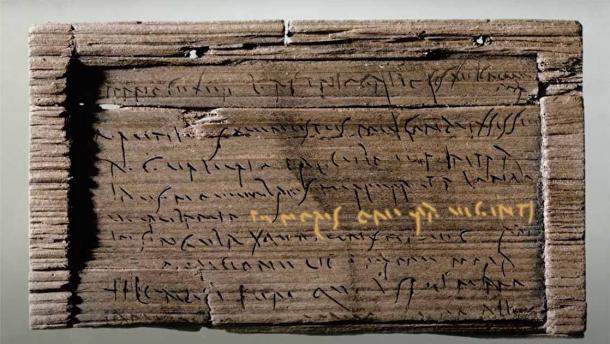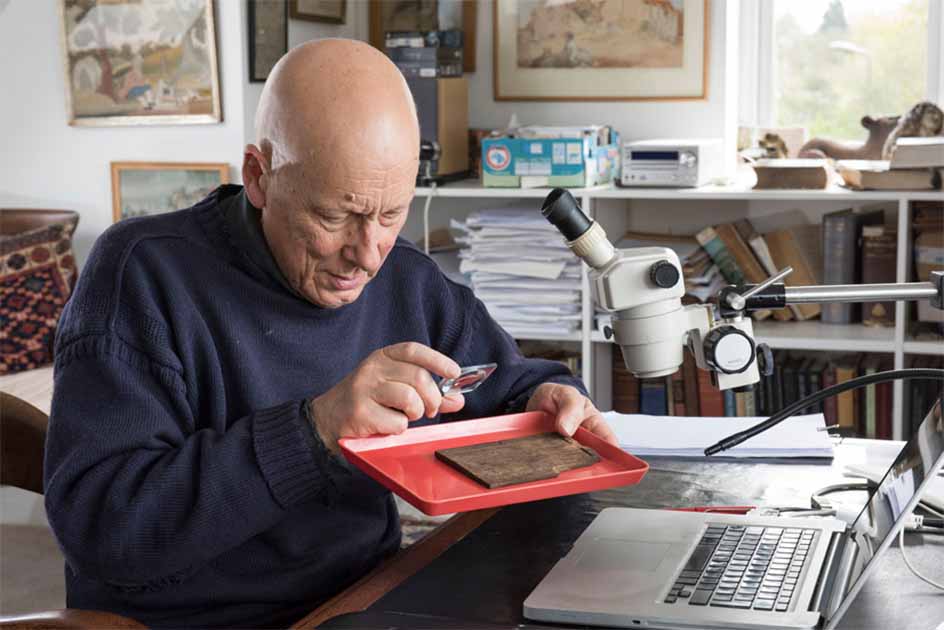2,000-Year-Old Bloomberg Tablets Reveal London Life Under the Romans
When archaeologists began excavations on the site of the demolished Bucklesbury House, little did they know that they would uncover the earliest written documents found in Britain. Dating from between 50-80 AD, the Bloomberg tablets are a series of written documents from the early Roman period found in what is now the financial heart of London. There were a staggering 405 tablets found of which 88 were translatable. The Bloomberg tablets vary in content, but they highlight the city’s affluent early history as well as offering “new” insights into the professions, social classes, and daily lives of the residents of Londinium nearly 2,000 years ago!

Perhaps the most historically significant of the Bloomberg tablets is a contract that is dated October 22 AD 62, which is shown here in highlighted form. The contract is about the transportation of 20 loads of provisions from Verularium (present-day St. Albans) to London. (YouTube screenshot / Inside Bloomberg)
The Discovery of the Bloomberg Tablets: Oldest Docs in the UK!
The Bloomberg tablets were first discovered during an excavation on the site of Bucklesbury House. The house was to be demolished to make way for the Bloomberg building, an office building that functions as the European headquarters for American company Bloomberg Inc.
This was not the first excavation of this site, however. A Roman temple of Mithras was previously found in 1952 when Bucklesbury House was being built. The site consisted of three acres (1.2 hectares) of the Roman city of Londinium. The tablet discovery site was located quite centrally in what was once Londinium, meaning the finds from the dig have great significance for our understanding of the settlement as a whole.
- Mithras, the Persian God Championed by the Roman Army
- Roman Mosaic in London is Largest To Be Uncovered in 50 Years
The Bucklesbury dig took place between 2010 and 2014 and the finds are one of the most extensive and significant collections of Roman artifacts ever found. Over 700 artifacts were found during the dig including the 405 tablets.
The Bloomberg tablets are wooden documents in which the writing was etched into a layer of beeswax applied to wooden pieces before they were used for recording events, transactions, etc. Although the wax hasn’t survived, the writing occasionally went through the wax to mark the wood. As tablets were reused, in some cases several layers of text built up on the tablets.
Text was inscribed on the waxed wood using “styli.” These were classical Roman writing utensils and 200 of these styli were found during the excavations.
The tablets were recovered in a waterlogged condition which probably helped preserve the wood and leather. To clean them, the tablets were washed gently with running water and a soft brush before preserving them with a polyethylene glycol immersion treatment. Then experts got to work on transcribing the tablets and uncovering the fascinating world of Roman London.
The Content of the Bloomberg Tablets: Debts and Trades . . .
"[The Bloomberg tablets] provide some very personal glimpses into the lives of the first Londoners" said Roger Tomlin, the Oxford Classics scholar pictured at the top of this article. Tomlin deciphered and translated the tablets.
The tablets include many examples of personal messages that humanize the early residents of London in a way rarely obtainable from archaeological evidence. For example, there is an urgent appeal by a man named Atticus to get his correspondent to pay up the 36 denarii (Roman currency) that he is owed.
Similarly, there is the misfortune of a financier called Titus whose ill-judged loan has made him the butt of the joke at the local market. As archaeologist Sophie Jackson put it, “It’s a bit like reading snippets of people’s emails.” While these types of documents may be the most interesting, they are far from the most important.

Probably the most significant Bloomberg tablets is this one from 65-80 AD in which London or “Londinio” is mentioned for the first time ever! (YouTube screenshot / Inside Bloomberg)
What do the Bloomberg Tablets Tell Us?
Perhaps the most historically significant tablet is a contract that is dated October 22 AD 62. The contract is about the transportation of 20 loads of provisions from Verularium (present-day St. Albans) to London. The date is important because it is just after the Boudican revolt when the native Celts rose up against the Romans, led by Boudica, Queen of the Iceni tribe.
According to the account written by Roman historian Tacitus, the Boudican revolt took place in 61 AD during which both London and St. Albans were destroyed. For a long time, historians have argued that the events must have taken place over two years, starting in 60 AD, and ending in 61 AD. This particular Bloomberg tablet gives strong evidence to support this theory.
Also significant is that one of these tablets contains the first mention of London, predating Tacitus’ mention of London in his “Annals” written between 115 and 120 AD. Dated between 65-80 AD, this tablet reads “Londinio Mogontio” which translates as “In London, to Mogontius.”
The tablets also provide evidence of schooling in the city, with one tablet depicting the alphabet written out. It has been theorized that this tablet was the result of a student practicing their writing.
A lot of the translated tablets contain general correspondence between merchants or businessmen related to contracts and loans. This supports the description Tacitus gave that London was full of businessmen. The names of 100 people from various social backgrounds were also found on the tablets, from a cooper, brewer, and judge to soldiers, slaves, and freedmen. Most of Londinium’s citizens were, however, businessmen and soldiers.
It has also been suggested that one of the ancient Roman London sites may have been one of London’s first ever office buildings. Archaeologists found 19 tablets in the remains of just one building, leading many to speculate about what the building was for. Unfortunately, none of the 19 tablets could be transcribed.
- Roman-Era London May Have Been as Ethnically Diverse as Today
- Archaeologists Uncover Spine-tingling New Hoard of Roman Letters at Vindolanda Fort
Lastly, the Bloomberg tablets contain the earliest known handwritten document ever in Britain. The tablet is dated January 8, 57 AD. The document is correspondence between two businessmen, both former slaves, and reads:
“In the consulship of Nero Claudius Caesar Augustus Germanicus for the second time and of Lucius Calpurnius Piso, on the 6th day before the Ides of January [8 January AD 57]. I, Tibullus the freedman of Venustus, have written and say that I owe Gratus the freedman of Spurius 105 denarii from the price of the merchandise which has been sold and delivered. This money I am due to repay him or the person whom the matter will concern…”
Top image: Roger Tomlin deciphering one of the 405 Bloomberg Tablets found at the heart of Roman Britain, Londinium, which are the oldest written documents ever found in the UK. Source:
By Mark Brophy
References
BBC. 2016. UK's oldest hand-written document 'at Roman London dig. Available at: https://www.bbc.com/news/uk-england-london-36415563
Current Archaeology. 2016. Earliest written reference to London found. Available at: https://archaeology.co.uk/articles/news/earliest-written-reference-to-london-found.htm
MOLA. 2016. Archaeological research into Britain’s oldest hand-written documents released. Available at: https://www.mola.org.uk/blog/archaeological-research-britain%e2%80%99s-oldest-hand-written-documents-released
Smith, R. 2016. Ancient Roman IOUs Found Beneath Bloomberg's New London HQ. Available at: https://www.nationalgeographic.com/history/article/ancient-rome-London-Londinum-Bloomberg-archaeology-Boudicca-archaeology
Tomlin, R.S.O. 2016. Roman London's first voices: writing tablets from the Bloomberg excavations, 2010–14. Available at: https://www.mola.org.uk/roman-londons-first-voices-writing-tablets-bloomberg-excavations-2010%E2%80%9314




















Comments
Great article! I love when speculation or back and forth between historians are settled with evidence. Although it may seem a bit intrusive to read the possible private matters between lenders, vendors, renters, or purchasers, at least we are learning the more intimate nature of the people. Imagine though, centuries from now future generations looking over your credit report lol